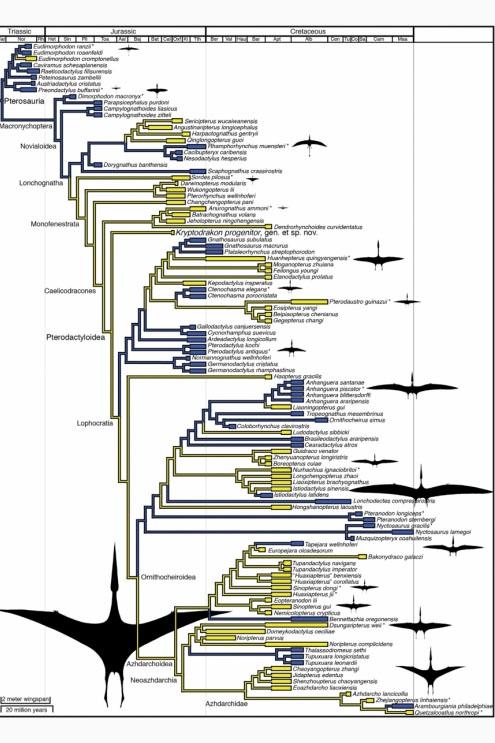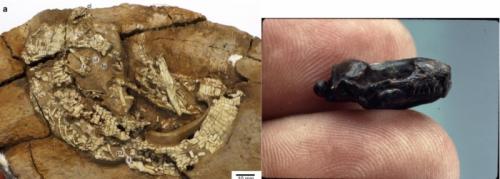Choiniere, J.N., J.M. Neenan, L. Schmitz, D.P. Ford, K.E.J. Chapelle, A.M. Balanoff, J.S. Sipla, J.A. Georgi, S.A. Walsh, M.A. Norell, X. Xu, J.M. Clark, and R.B.J. Benson. 2021. Evolution of vision and hearing modalities in theropod dinosaurs. Science 372 610-613.
Moore, A.J., P. Upchurch, P.M. Barrett, J.M. Clark and X. Xu. 2020. Osteology of Klamelisaurus gobiensis (Dinosauria, Eusauropoda) and the evolutionary history of Middle–Late Jurassic Chinese sauropods. Journal of Systematic Palaeontology 18(16): 1299-1323. doi.org/10.1080/14772019.2020.1759706
Leardi, J.M., D. Pol., and J.M. Clark. 2020. Braincase anatomy of Almadasuchus figarii (Archosauria, Crocodylomorpha) and a review of the cranial pneumaticity in the origins of Crocodylomorpha. Journal of Anatomy 237(1): 48-73. doi.org/10.1111/joa.13171
Qin, Z., J. Clark, J. Choiniere, and X. 2019. Xu A new alvarezsaurian theropod from the Upper Jurassic Shishugou Formation of western China. Scientific Reports 9(11727): doi.org/10.1038/s41598-019-48148-7.
Xu, X. et al. 2019. Two Early Cretaceous fossils document transitional stages in alvarezsaurian dinosaur evolution. Current Biology 28(17): 2853-2860. doi.org/10.1016/j.cub.2018.07.057
Dollman, K., J.M. Clark, M. Norell, X. Xu, and J. Choiniere. 2018. Convergent evolution of a eusuchian-type secondary palate within Shartegosuchidae. AMNH Novitates 3901. doi.org/10.5531/sd.sp.31
Moore, A.J., J. Mo, J.M. Clark and X. Xu. 2018. Cranial anatomy of Bellusaurus sui (Dinosauria: Eusauropoda) from the Middle-Late Jurassic Shishugou Formation of northwest China and a review of sauropod cranial ontogeny. PeerJ 6:e4881. doi.org/10.7717/peerj.4881
Han, F.-l., C.A. Forster, J.M. Clark, and X. Xu. 2017. Postcranial anatomy of Yinlong downsi (Dinosauria: Ceratopsia) from the Upper Jurassic Shishugou Formation of China and the phylogeny of basal ornithischians. Journal of Systematic Palaeontology 16(14): 1159-1187. doi.org/10.1080/14772019.2017.1369185
Leardi, J.M., D. Pol and J.M. Clark. 2017. Detailed anatomy of the braincase of Macelognathus vagans Marsh, 1884 Archosauria, Crocodylomorpha) using high resolution tomography and new insights on basal crocodylomorph phylogeny. PeerJ 5:e2801; DOI: 10.7717/peerj.2801
Wang, S., J. Stiegler, R. Amiot, X. Wang, G-h Du, J.M. Clark, and X. Xu. 2016. Extreme ontogenetic changes in a ceratosaurian theropod. Current Biology 27: 144-148.
Andres, B., J. Clark, and X. Xu. 2014. The earliest pterodactyloid and the origin of the clade. Current Biology 24(9): 1011–1016.
Choiniere, J.N., J.M. Clark, M.A. Norell, X. Xu. 2014. Cranial osteology of Haplocheirus sollers Choiniere et al., 2010 (Theropoda: Alvarezsauroidea). American Museum of Natural History Novitates 3816: 1-44.
Choiniere, J., J.M. Clark et al. 2013. A juvenile specimen of a new coelurosaur (Dinosauria: Theropoda) from the Middle–Late Jurassic Shishugou Formation of Xinjiang, People’s Republic of China. Journal of Systematic Palaeontology 12(2): 177-215.
Pol, D., O.W.M. Rauhut, A. Lecuona, J.M. Leardi, X. Xu, and J.M. Clark. 2013. A new fossil from the Jurassic of Patagonia reveals the early basicranial evolution and the origins of Crocodyliformes. Biological Reviews 88(4): 862-872.
Brinkman, D.B., D.A. Eberth, X. Xu, J.M. Clark, and X.-C. Wu 2013. Turtles from the Jurassic Shishugou Formation of the Junggar Basin, People’s Republic of China, with comments on the basicranial region of basal Eucryptodires. Pp. 147-172 in: D. B. Brinkman, P. A. Holroyd, and J. D. Gardner (editors), “Morphology and Evolution of Turtles: Origin and Early Diversification”.Springer Verlag, Dordrecht.
Clark, J.M. 2011. A new shartegosuchid crocodyliform from the upper Jurassic Morrison Formation of western Colorado. Zoological Journal of the Linnean Society 163 Supplement 1, S152-S172.
Andres, B., J. Clark, and X. Xu 2010. A new rhamphorhynchid pterosaur from the Upper Jurassic of Xinjiang, China, and the phylogenetic relationships of basal pterosaurs. Journal of Vertebrate Paleontology 30(1): 163-187.
Choiniere, J., X. Xu, J. Clark, C.A. Forster, G. Yu, and H. Fanlu. 2010. A basal alvarezsaurid theropod from the early Late Jurassic of Xinjiang, China. Science.327: 571-574.
Eberth, D.A., X. Xu, and J.M. Clark. 2010. Dinosaur death pits from the Jurassic of China. Palaios 25: 112-125.
Choiniere, J., J. Clark, X. Xu, and C. Forster. 2010. A basal coelurosaur (Dinosauria: Theropoda) from the Shishugou formation in Wucaiwan, People’s Republic of China. Journal of Vertebrate Paleontology 30: 1773–1796.
Xu, X., J. Clark, J. Mo, J. Choiniere, C.A. Forster, G.M. Erickson, D.W.E. Hone, C. Sullivan, D.A. Eberth, S. Nesbitt, Q. Zhao, R. Hernandez, C.-k Jia, F-l. Han and Y. Guo. 2009. A Jurassic ceratosaur from China helps clarify avian digital homologies. Nature 459: 940-944.
Xu, X. J.M. Clark, C.A. Forster, M.A. Norell, G.M. Erickson, D.A. Eberth, C. Jia, Q. Zhao. 2006. A basal tyrannosauroid dinosaur from the Late Jurassic of China. Nature 439: 715-718.
Xu, X., C.A. Forster, J.M. Clark, and J. Mo 2006. A basal ceratopsian with transitional features from the Late Jurassic of northwestern China. Proceedings of the Royal Society of London (B) 273(1598): 2135-2140.
Kirkland, J.M. L.E. Zanno, S.D. Sampson, J.M. Clark, and D. Deblieux. 2005. A primitive therizinosauroid dinosaur from the Early Cretaceous of Utah. Nature 435: 84-87.
Clark, J.M., X. Xu, C.A. Forster, and Y. Wang. 2004. A Middle Jurassic ‘sphenosuchian’ from China and the origin of the crocodylian skull. Nature 430: 1021-1023.
Kearney, M. and J. Clark. 2003 Problems due to missing data in phylogenetic analyses including fossils: a critical review. Journal of Vertebrate Paleontology 23: 263-274.
Clark, J.M., M.A. Norell, and P. Makovicky 2002. Cladistic approaches to the relationships of birds. Chapter 2 in: "Mesozoic Birds; Above the Heads of Dinosaurs," L. Chiappe and L. Witmer, editors, University of California Press.
Clark, J.M., M. Norell, and L. Chiappe 1999 An oviraptorid skeleton from the Late Cretaceous of Ukhaa Tolgod, Mongolia, preserved in an avian-like brooding position over an oviraptorid nest. American Museum Novitates 3265, 36 pp.
Reynoso, V.H. and J.M. Clark 1998 A dwarf sphenodontian from the Jurassic La Boca Formation of Mexico. Journal of Vertebrate Paleontology 18:333-339.
Clark, J.M., J. Hopson, R. Hernández, D. Fastovsky, and M. Montellano 1998 Foot posture in a primitive pterosaur. Nature 391:886-889.
Clark, J.M. and R. Hernández 1994 A new burrowing diapsid from the Jurassic of Mexico. Journal of Vertebrate Paleontology 14:180-195.
Norell, M., J.M. Clark, Dashzeveg D., Barsbold R., L.M. Chiappe, A.R. Davidson, M.C. McKenna, Perle A., and M.J. Novacek. 1994 A theropod dinosaur embryo and the affinities of the Flaming Cliffs dinosaur eggs. Science 266:779-782.









